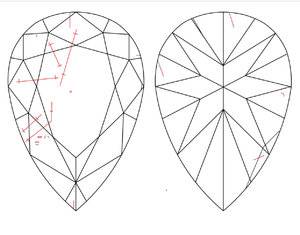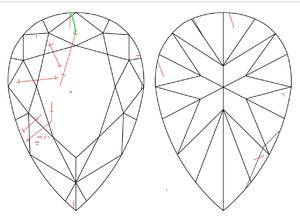diamondbeez
Rough_Rock
- Joined
- Feb 10, 2018
- Messages
- 8
Hi everyone!
I’m freaking out a little bit because I dropped my ring recently while cleaning it and I obviously looked at it with a loupe to see if any damage was done to the diamond. When I looked with the loupe, I saw a “new” twinning wisp extending from an already existing one. Is it possible for twinning wisps to expand in size from impact? It wasn’t a big drop at all, I just dropped it to the table instead of the floor. The drop was probably less than 6 inches high. I don’t know which part hits the table (I have a pear diamond) but it was on the tip (not the rounded end) when I picked it up. The tip doesn’t seem to be chipped (there’s a v prong protecting it). Anyway, I’m pretty sure this hairline wasn’t there before, and now if the light hits the facet just right I can see the very thin line. It’s also not on the inclusion plot while the already existing one it “extended” from is there (and i know about all the other twinning wisps and feathers etc at the time of purchase). Hence, I was wondering if this wisp could be one of the wisps that’s mentioned in the additional comments section- “additional twinning wisps, clouds, pinpoints and surface graining are not shown”, or it actually extended from the already existing one. This is an SI 1 stone if that helps.
I’ve included a picture of the original inclusion plot and the same plot with a new line I drew (in green) to indicate where this “new” wisp is.
The new line is super fine and like I said, is not visible unless the light hits it at a very specific angle on the facet. The reason why I believed it wasn’t there before is because when the light hits it the same way before, this line wasn’t visible. Now, it touches the side of the feather and extends to the girdle (like the feather). Also, when I louped it before, it wasn’t there too. Please help and tell me if it is a cause for concern! Thanks!!
Original:

With “new” wisp drawn in green

I’m freaking out a little bit because I dropped my ring recently while cleaning it and I obviously looked at it with a loupe to see if any damage was done to the diamond. When I looked with the loupe, I saw a “new” twinning wisp extending from an already existing one. Is it possible for twinning wisps to expand in size from impact? It wasn’t a big drop at all, I just dropped it to the table instead of the floor. The drop was probably less than 6 inches high. I don’t know which part hits the table (I have a pear diamond) but it was on the tip (not the rounded end) when I picked it up. The tip doesn’t seem to be chipped (there’s a v prong protecting it). Anyway, I’m pretty sure this hairline wasn’t there before, and now if the light hits the facet just right I can see the very thin line. It’s also not on the inclusion plot while the already existing one it “extended” from is there (and i know about all the other twinning wisps and feathers etc at the time of purchase). Hence, I was wondering if this wisp could be one of the wisps that’s mentioned in the additional comments section- “additional twinning wisps, clouds, pinpoints and surface graining are not shown”, or it actually extended from the already existing one. This is an SI 1 stone if that helps.
I’ve included a picture of the original inclusion plot and the same plot with a new line I drew (in green) to indicate where this “new” wisp is.
The new line is super fine and like I said, is not visible unless the light hits it at a very specific angle on the facet. The reason why I believed it wasn’t there before is because when the light hits it the same way before, this line wasn’t visible. Now, it touches the side of the feather and extends to the girdle (like the feather). Also, when I louped it before, it wasn’t there too. Please help and tell me if it is a cause for concern! Thanks!!
Original:

With “new” wisp drawn in green








300x240.png)